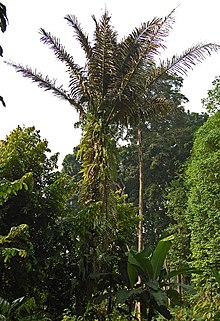Arenga pinnata
| Arenga pinnata | |
|---|---|
 |
|
| Scientific classification |
|
| Kingdom: | Plantae |
| Clade: | Tracheophytes |
| Clade: | Angiosperms |
| Clade: | Monocots |
| Clade: | Commelinids |
| Order: | Arecales |
| Family: | Arecaceae |
| Genus: | Arenga |
| Species: |
A. pinnata
|
| Binomial name | |
| Arenga pinnata | |
Arenga pinnata (syn. Arenga saccharifera) is an economically important feather palm native to tropical Asia, from eastern India east to Malaysia, Indonesia, and the Philippines in the east.[1] Common names include sugar palm, areng palm (also aren palm or arengga palm), black sugar palm, and kaong palm, among other names.[2][3]
It is a medium-sized palm, growing to 20 m tall, with the trunk remaining covered by the rough old leaf bases. The leaves are 6–12 m long and 1.5 m broad, pinnate, with the pinnae in 1–6 rows, 40–70 cm long and 5 cm broad. The fruit is subglobose, 7 cm diameter, green maturing black.[4]
It is not a threatened species, though it is locally rare in some parts of its range. It serves as an important part of the diet of several endangered species, including cloud rats of the genus Phloeomys.
Uses
Sap
The sap is harvested for commercial use in southeast Asia, yielding a sugar known in India as gur or in Indonesia as gula aren. The sap is collected and made as lahang, a traditional cold sweet drink, and is also fermented into vinegar (Filipino sukang kaong) and palm wine (Filipino tubâ, Malaysian and Indonesian tuak).[3][5][6]
Edmund Roberts talks about drinking an alcoholic beverage made in the Cavite area. He described it as a “fermented” and “intoxicating liquor”. He said that it was “the pith furnished with sugar – when the liquor was properly boiled down, a farina…and of the inside of its triangular-shaped fruit a sweetbread was made.”[7]
Sugar (jaggery) is also commonly derived from the fresh sap in Indonesia and the Philippines. These are traditionally prevented from fermenting by placing crushed chili or ginger in the collecting container. The sap is boiled until it reduces to a thick syrup which is then dried into a brown sugar. Similar sugar extraction methods are also traditionally used for other sugar palms, like the buri palm (Corypha elata).[3]
The raw juice and pulp are caustic. This crop may develop into a major resource of biofuel (ethanol)[citation needed].
Fruit
The immature fruits are widely consumed in the Philippines (called kaong) and Indonesia (called buah kolang-kaling or buah tap) and are made into canned fruits after they are boiled in sugar syrup.[3]
Fibres
The dark fibrous bark (known as doh[what language is this?] in India; ijuk in Indonesia; and yumot or cabo negro in the Philippines), is manufactured into cordage, brushes, brooms, thatch roofing, or filters.[3]
According to the study on bas-reliefs of Javanese ancient temples such as Borobudur, this type of roof are known in ancient Java vernacular architecture. It can be found today in Balinese temple roof architecture and Minangkabau Rumah Gadang gonjong horn-like curved roof architecture, such as those found in Pagaruyung Palace.[citation needed]
Leaves
The leaves as well as the leaf midribs can be used to weave baskets and marquetry work in furniture.[3]
Starch
In Indonesia, starch can also be extracted from sugar palms and used in place of rice flour in noodles, cakes, and other dishes.[3]
(The upper Information from Wikipedia)
Usage and products we are doing in Silimalombu
Palmwine
We offer our guests the fresh palm wine from our trees. This is the fresh fermented juice from the tree. It is not more old then one day and it is fermented by a natural milk acid fermentation, not primary by yeast. The process is getting started by a bark from the tree Raru. The bark also has huge health benefits.
The milk Acid bacterials (LAB) can heal bacterial infections of the stomach. It is active
Palmwine Zero
We de-alkoholize the Tuak and sterilize it and fill it to bottles. This juice has now all the health benefits of the minerals and other elements but without Alkohol and only with a little rest of the sugar. Before we sterilize it, we wait until all the sugar is fermented. Then we cook it. Out of this, the juice is nearly without Alcohol and sugar. But still all the other things are still inside. Now you have a sour refreshing helathy drink without any compromise. In the bottles it can stay for years. It is nice to drink it like it is or you cool it down and drink it with ice.
A video from Health benefits on youtube:
What you can make else out of the Sugar Palm and how people make Business out of the tree.

